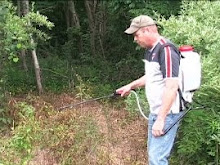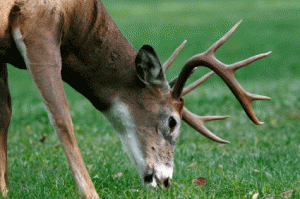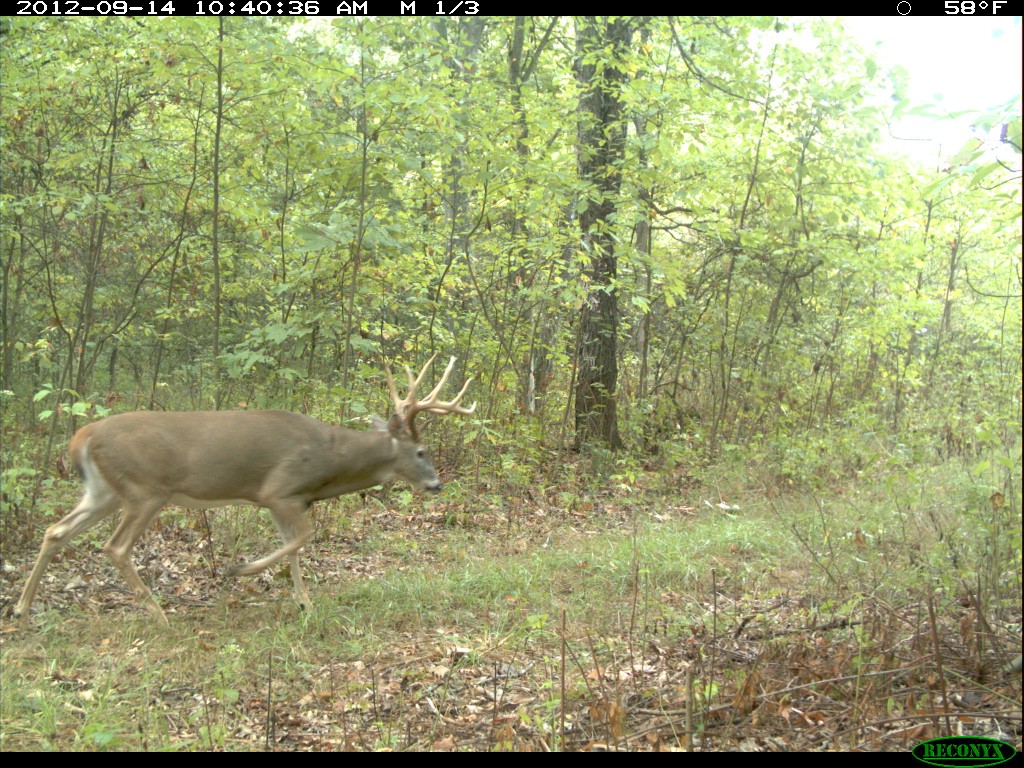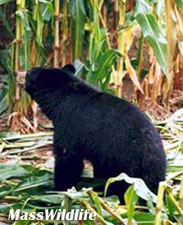homepagebackup
Is this site right for you? The following questions should help answer that:
Do you spook deer more than 5% of the time when going to or from your stand?
Your property can and should be laid out in a way that offers maximum hunting opportunities, while minimizing your activities. A properly planned layout is job 1.
Do you notice a drop off in deer sightings the more you hunt a stand?
If so, either stand access, departure or placement is not setup to provide the ghost factor.
Another probable issue is that your stands are either not targeted for each phase of season or not in the best
locations. Through careful planning and property layout, we can help make each trip to the stands provide maximum
hunting opportunities.
Are your biggest bucks nocturnal?
To an extent, this is to be expected. However, most properties are laid out and hunted in a way that makes this
situation far worse than it has to be. Their layout and hunting efforts most often actually train deer not to move in
the daylight. Between making you a ghost in the woods and careful design of sanctuaries – areas that are off limits
to human activities – we can train them to move during daylight hours, with a design to focus movement past your stands.
Are more than 90% of the scouting cam pics you get of the bucks you want to kill during the dark?
If you aren’t getting more than 10% daylight pictures of the bucks you want to kill, odds are very good our staff can
help. The properties we manage provide 15, 20, 25 and even as high as 35% daylight pics of the bucks we want to
kill. Again, it’s all in layout, the ghost factor and allowing these bruisers to feel safe moving during daylight hours.
Do the deer numbers on your property plummet each fall after leaf drop?
If yes, your own hunting pressure, the property’s lack of protective cover or both are likely to blame. As noted, we will
show you how to make deer feel safe, but that only goes so far. The other issue is that these deer require a surplus
of thick, protective cover to WANT to be on your property during daylight. We will give you several tools to effectively
accomplish that.
Once hunting season really starts ramping up, do you see more or less deer?
Each year, the deer numbers climb on our staff’s properties as hunting season
progresses. We can help you identify the problem and reverse it.
Do you struggle to establish thriving food plots?
If yes, there may be many reasons why. Perhaps your soil health is lacking, maybe your planting techniques need
adjusting or you may be planting seed types that will not thrive in your specific soils/climate. This is yet another area
where our incredible staff shines. With a vast array of experience establishing food plots in nearly every condition
imaginable, if plants can grow, we can help you realize that lush, deer drawing plot.
Are your food plots hot during certain times of season and a desert during the rest?
This is a far too common problem that can be easily addressed by mixing plantings to ensure that a desirable food
source is available throughout the entire season. In fact, we can most often suggest blends of seeds that will feed
deer the entire year, which can be critical in improving the quality of animals you hunt.
Do your food plots run out before season ends?
Even on small plots, showing you how to deliver a 1-2 punch will significantly increase the length of time your food
plots are drawing and feeding deer.
If you are at a loss of how to combine the above Q & A into a comprehensive property plan you are in the right spot.
Most of our customers had little knowledge of how severely their activities diminished the quality of their hunting. Flat out nothing is as important for improving both the
habitat and hunting as having a well-constructed plan. This plan should not only address how to improve the habitat
for deer (resulting in its ability to healthily support more and more physically robust deer) and be laid out in a manner
to drastically improve your hunting, but each and every improvement must work together, all towards a common goal.
There’s no doubt in our mind that you can not find a full staff of individuals that are as qualified to help as ours. Yes,
we know what a bold statement that is. So, don’t take our word for it. Check the bios when our new site is unveiled
and dare to compare.
When considering making improvements, do you worry if you are making the right moves in the right locations?
If yes, good for you! This should be a serious concern. Even simply making habitat improvements that your land
desperately needs can actually hamper your ability to allow your property to reach its full potential, IF it`s done in the
wrong location or not working in unison with other improvements and habitat features.
What makes our site so special?
Frankly, it’s our staff. There are other highly qualified individuals that provide habitat and hunting consulting services.
However, most often work individually or in pairs. We applaud their efforts and believe the best of those groups
provide an invaluable service to their clients. However, there is more than a grain of truth to the old saying that
there is great strength in numbers. When one reviews our team, you will find it contains several of the top whitetail
research biologists, renowned how-too whitetail hunting “experts”, several top end habitat and hunting consultants
and a tremendous wealth of experience in applying these principles in a hands on manner on a wide variety of
habitat types. These guys don’t just show others how to do it. They have many, many years’ experience of doing it
themselves. To put it bluntly, it’s a dream team of the best of the best.
A major problem is that we’ve been trained by magazines and TV to believe food plots are not only THE answer, but
the ONLY answer to improving our hunting and growing and holding bigger bucks. If you believe that, don’t feel bad.
It’s been a carefully orchestrated and very effective advertising campaign that has trained many of today’s hunters
and land owners to believe that. Most importantly, it’s helped keep hidden from us that there is so much more to
improving the hunting on one’s property. Are food plots important? Of course they are, but they are only one part
of a five part equation. We WILL give you that equation and show you how to use it to come to the right answer for
making the hunting on your property the best it can possibly be.
We understand that membership in this site will not be for everyone. Frankly, there’s only so much we can do to help
someone that owns 5 acres with a house in the middle of it. In that case, you’ll likely benefit from being one of our
free members, but we suggest you think carefully about even joining our P&Y ranks. Even those small membership
fees will likely not be worth the extra value in that circumstance. Don’t get us wrong. Some 5 acre pieces can provide
great hunting! We just want to be certain you get your value.
The same applies to those that just plain can’t spare 20 hours a year to work on their habitat or afford to pay
someone to do that work for them. Again, the free membership will no doubt help, but any of the paid levels are
unlikely to provide you with the value you deserve. One doesn’t have to invest countless hours to get a benefit from
many of our techniques, but many do require some time investment, whether it’s yours or hiring someone else.
For the most of the rest of you, we firmly believe we can provide a service whose worth blows our membership fees
away. As you will be able to clearly see by our pricing, our goal is not to get rich off of this. It’s to provide as much
value as we can, while being able to cover our expenses. If we cannot provide a value well above and beyond what
we charge, we have failed.
Food plots failed
So its midsummer and you decided to take a little drive and check out your bean and corn food plots
Deer management
for deer. You get there and what do you find? Nothing the deer are going to be flocking to. Its a bummer when your food plots failed, but you have options. Today we are going to break down one example of how you can make lemonade when your food plots failed.
Food plots failed
 Today finds us in the upper midwest, looking at a food plot of soybeans that never really germinated. We may have planted them too deep, or the seed may have been old, but either way they did not grow. We need some good tonnage as this is a high deer density area so we have decided to plant a brassica blend. 2 pounds rape, 3 pounds of purple top turnips, and 5 pounds of a tillage radish on 1.5 acres. Luckily when we look through the weed bed bed, we can see enough dirt to know that one good rain will pound our tiny seeds into the ground for soil contact. We are going to spray, then fertilize, and then broadcast our seed. 400 pound of triple 19 willl do the trick here, and we may top dress with 200 lbs of urea later on, especially if we notice the leaves turning purple, indicating a lack of nitrogen.
Today finds us in the upper midwest, looking at a food plot of soybeans that never really germinated. We may have planted them too deep, or the seed may have been old, but either way they did not grow. We need some good tonnage as this is a high deer density area so we have decided to plant a brassica blend. 2 pounds rape, 3 pounds of purple top turnips, and 5 pounds of a tillage radish on 1.5 acres. Luckily when we look through the weed bed bed, we can see enough dirt to know that one good rain will pound our tiny seeds into the ground for soil contact. We are going to spray, then fertilize, and then broadcast our seed. 400 pound of triple 19 willl do the trick here, and we may top dress with 200 lbs of urea later on, especially if we notice the leaves turning purple, indicating a lack of nitrogen.

Bears love corn
Food plots failed
The plan is to not disturb the seed bed by turning the dirt, and by spraying the short weeds, they will fall over our seeds making a blanket to trap the moisture for germination during the heat of summer. These seeds may struggle with limited rain, but the compost we will make is like a dead nurse crop that helps our young plants get started.
Food plots failed
This technique will work for addressing low spots that died out, or very weedy areas that need some help before the deer season. Your food plots failed in spots, but you can jump in there with a backpack sprayer and some seed and be back in the game. If you fertilized well early on, take some of those credits and use less this go around, but always fertilize brassica. Many food plots failed because it was not fertilized.
By planting our brassica 70 days before the first average frost, we will hit that 60 – 90 day window that allows lots of growth and tonnage of forage, without letting the plants mature making them unattractive to the deer herd. We sprayed, planted and fertilized this plot on only 3 hours. It helps that we did not have to work the dirt because we could see it, and even though our food plot failed, we will still have greens this fall. Check the average first frost in your area to discover a good time to easily plant a brassica blend when your food plots failed.
Fall food plots for deer
 Fall food plots for deer consist of either annuals like corn and beans planted in the spring, or annuals, perennials and bi-ennials planted late summer. Today we will focus on a strategy for attracting bucks in the early bow season and until the first few hard frosts in areas where the deer feed heavily on clover, alfalfa or soybeans all summer long. Described as a green to green transition, this fall food plots for deer strategy is a dynamite way to get close shots at the biggest deer on your property.
Fall food plots for deer consist of either annuals like corn and beans planted in the spring, or annuals, perennials and bi-ennials planted late summer. Today we will focus on a strategy for attracting bucks in the early bow season and until the first few hard frosts in areas where the deer feed heavily on clover, alfalfa or soybeans all summer long. Described as a green to green transition, this fall food plots for deer strategy is a dynamite way to get close shots at the biggest deer on your property.
Early fall food plots for deer are green and growing
As summer rolls into early fall, most of the plant life is shifting the focus from growth to seed production and energy transfer to it’s root system. When this happens your deer herd will shy away from previously attractive soybeans, clovers, forbs and grasses because as they stop growing, they just do not taste as good. Your job as a hunter is to find what they are switching over to and hunt that source. Acorns are key this time of year but they are everywhere and hard to hunt. Your best strategy is to give them some fresh green growth that is tasty and attractive. A late season planting is the best fall food plots for deer strategy in this scenario.
The first frost marks a huge shift in active fall food plots for deer
Nothing will turn the switch faster on which fall food plots for deer your herd is using quicker than that first killing frost. Within days the beans all yellow and virtually all plant growth is done for the year. Certain annual grasses such as cereal rye, winter oats, and winter wheat as well as triticale are a super draw for the next 3 – 6 weeks or longer depending on snowfall amounts and where you live. In Minnesota I plant these cereal grains in late August, preferably the last week. I may fudge earlier or later if the clouds say rain, but if I can get these grasses in late August I am rich with deer in the early bow season. They will withstand frost after frost and keep right on growing, providing one of the highest quality, lowest cost deer attractants you can buy.
Fall food plots for deer as a nurse crop
Do not ignore the power of these crops as a nurse crop in your fall food plots for deer. Add clover, alfalfa, or vetch or any other perennial to the blend, and these perennial crops will receive minimal pressure in the fall allowing them to establish their root systems and thrive the next few years. It’s a killer fall food plots for deer strategy.
the blend, and these perennial crops will receive minimal pressure in the fall allowing them to establish their root systems and thrive the next few years. It’s a killer fall food plots for deer strategy.
Size of these green to green fall food plots for deer
I prefer to establish these small green plots by first picking the tree I want to hunt. It’s much easier to pick an area to plant, but the best plots are always strategically located where deer like to travel, and more importantly in spots you can access without spooking and educating deer. If you can only hunt it once it’s a waste of time to play with. I also like to keep these spots small. On my farm I transition the deer from a 3 acre soybean field to a 1/10 acre green spot. I can almost shoot the whole plot with my recurve. Every one of the deer I watch in the beans in July and August will transition to the only green growing chow after the first hard frost. Like fish in a barrel? Hardly. But it is one of the best fall food plots for deer.




